| LED advantages compared to incandescent light sources: | LED disadvantages include: |
|---|---|
Costs:
Par 16 (airplane runway light style) fixtures can cost around $30 with Par 64s (large / 8” equivalent for theatre usage) fixture are roughly $90.
ETC Source Four PAR costs roughly $320 each and uses a lamp that costs roughly $20.
LED Pars use LEDs that are built into the fixture (typically meaning the lamps aren’t replaceable). Some LED Pars are white (can be colored with gel) most often for retail and museum installations… Most are either RGB or RGBW (or some other mix of oddball colors to produce a dynamic color range by mixing). LED pars tend to use little electricity and don’t need physical dimmers; but require DMX (Digital Multiples – see that segment) signal to control the intensity and color of the fixture via a lightboard or enabled computer. Inexpensive DJ quality (imperfect color rendition, limited brightness) can cost as low as $100 (cheaper aren’t even worth looking at) aren’t really bright enough for use on a large stage, but can tint some scenery with a color wash.
Entertainment-Industry White LED pars generally cost beginning at $900.
Entertainment-Industry color LED pars (like this ETC Desire D60X Studio HD LED Par) runs roughly $3,620. while an ETC Desire D60 Vivid costs roughly $2,900. Both of these use a (different) 7-color system.
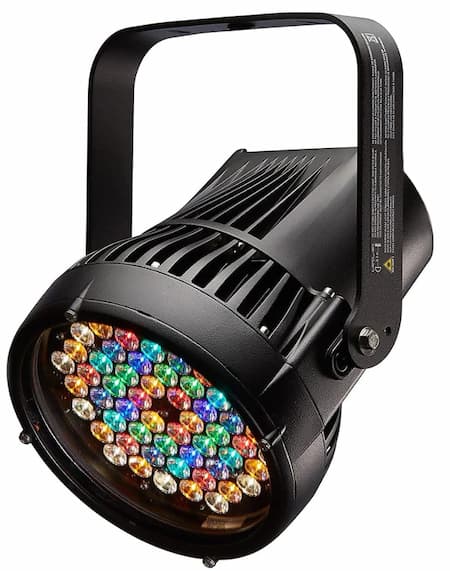
ETC Edisre D60X Studio LED par costs roughly $3,620.
Image courtesy ETC
Costs
Incandescent Altman leko $575 with lens tube
Incandescent Source 4 Zoom (15-30 degree or 25-50 degree) $1,000
*each of these use lamps that cost about $20. ETC Source 4 LED Series 3 (flexible color) $3,000 with lens tube
The Lustr X8 array includes a mix of green, lime, blue, indigo, cyan, amber, red and deep red LEDs.
Altman LED (flexible color) $2550 with lens tube
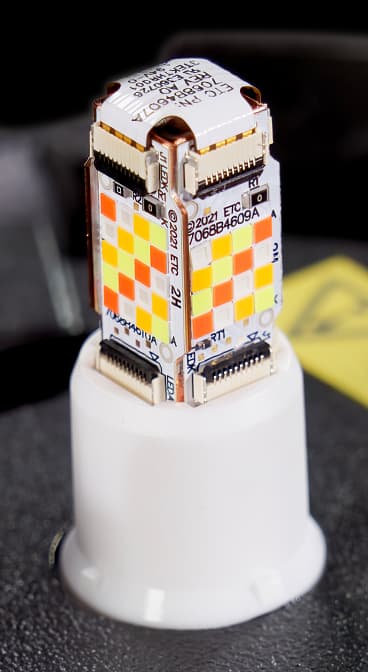
ETC Source 4 WRD Color Series II LED
Image courtesy ETC

ETC Source 4 WRD Color Series II kit
Image courtesy ETC
In this photo, provided by ETC of a Source 4 LED color kit; you can see that the lamp is comprised of multiple LEDs on a 4-sided chip, and the kit comes with an ultra-efficient ellipsoidal reflector. Why isn’t the reflector a smooth, curved ellipse? While early fixtures had smooth reflectors, modern designers figured out that because the filament (light source) isn’t actually a single point; the near-square shape more similar to the size of the filament is more effective.
|
Far cycs tend to throw about a 5'-6' "column" of light; so you'd need approximately one unit for every 6' width of cyc or drop you're trying to light. Example: A 30' wide drop would need 6 fixtures per color (or 6 LED color-tunable cyc units) for a smooth wash. |
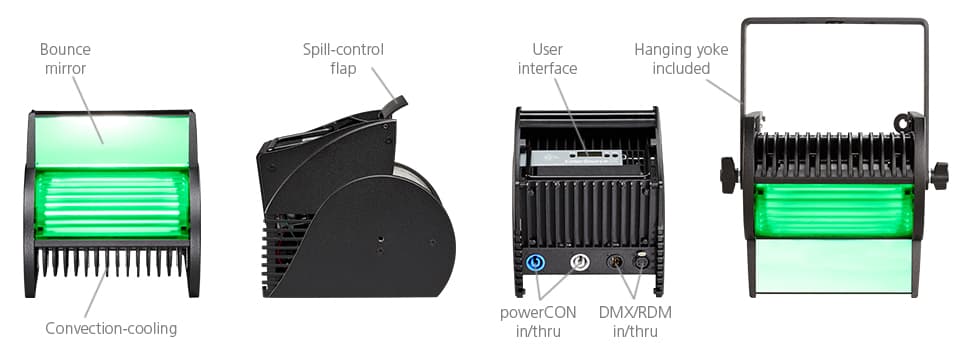
ColorSource CYC by ETC
Approximate cost: $1,900/each as of December, 2023
Having trouble with the above video? Watch it directly on Vimeo or YouTube.
Prefer to read the transcript here? Collapsible
Let’s look at some lights!
For this demonstration I’m going to use a high-end disc jockey (DJ) style DMX control board. Overall simple in design, it’s highly portable because its simple 2-line LED display is built in, and this board has a joystick which can be fun with moving light fixtures.
This light board has only one DMX 512 output, and uses the less expensive 3-pin XLR connector. That also means we’ll have to connect all of our lights in one continuous chain.
As for the fixtures, let’s start with some relatively simple Light Emitting Diode (LED) pars. We need to start by plugging the units in to both power (these units use American standard 120 volt AC with Edison connectors) and to our lightboard via a 3-pin DMX cable. In order to control both of these units, we’ll need to daisy-chain them by connecting one to our lightboard, then the second unit to the first unit.
To keep our signal clean, we’ll add a terminator to the second fixture.
These par 38s have a few different modes that are available, including sound-activated and slave options; but we’re more concerned with controlling them with DMX, so we need to give them a DMX address. I’m going to set them to address 25. I’ll explain why I chose that number a little later. For the moment, so that I can control both of these units at the same time, I’m going to set them both to address 25.
Before we can use these lights, we need to load their fixture profile into our control board.
Many lightboards have different procedures for handling the same information, On this one, we’re going to choose “Fixture” then unit “3”. This board doesn’t have a profile for these exact Par 38’s, but its generic Par 36 and Par 64 profile will serve us just fine. We could also use the generic 32 DMX profile, but that would use up 32 channels; when these units only need 3 for our purposes.
Some fixtures use 32 DMX channels; this board breaks those into banks of 8 which can be active at one time. In this case, we have control over the three primary colors; Red Green and Blue, in that order, from “0” to full intensity. Remember that DMX has a range of 255; so full in this case is 255, not 100. Programming fixtures via DMX takes a little more planning and effort than standard lighting units and dimmers. With a standard parcan, we’d only have one color frame in the unit, but we’d only have to set one channel’s worth of information; intensity. In this case, we have to set 3 channels, but we can choose our colors “on the fly”.
Once we’re happy with our cue, we can record this as a preset.
Perhaps we don’t want both fixtures to be controlled by the same channels; while this control can be useful for a full stage wash, sometimes a designer wants more control than that. In this case, we can simply change the address of one of the pars. Let’s make one of them address 26. Now when we set a level for channel 1, only red from par 1 reacts, as expected. However, when we bring up channel 2, we get odder results. And if we jump to one of our presets instead, again we get inconsistent results.
The reason for this is that while par one is set to address 25, it actually makes use of three channels; so DMX address 25, 26 and 27 are controlling par 1. By setting par 2 to address 26, it also follows information from 26, 27 and 28, but in the same color order, so we get unintended results.
To control the units discreetly, we must leave DMX channels 25-27 free. So, let’s set par 2 to address 28. Now we have full control over each fixture independently. Realize that the presets we recorded only affect par 1 because channels 28 through 31 were at zero when we recorded these looks.
Let’s take a look at some even smarter intelligent fixtures.
Moving fixtures fall in to 2 general categories, moving heads and moving mirrors. There are, of course, advantages and disadvantages to each. Moving mirrors tend to be less expensive overall, take up less room, and can be quieter. Their chief disadvantages tend to be that they have less range of motion and often have less features.
This is a LED scanner which uses 8 channels. Not all scanners are created equally of course. This one was really designed for use in clubs by DJs, but it does offer us controls for:
Pan
Tilt
Colors
Gobos
Shutter / Strobe
Dimmer / Intensity
12 preset movement washes
And a speed control for those movements
This fixture connects the same way, with a DMX input which we’ve daisy-chained from the pars, and I’ve addressed it to DMX 17. Because it uses 8 channels, it actually uses channels 17-24, which is why we set our first par to address 25.
Again we have to load a fixture profile into our board. Into fixture 2 I’m going to set it to the Accuscan 250; which is this particular unit.
This fixture uses a color wheel which has 8 colors plus white. These colors are created by glass gels which are not changeable, so we can not mix custom colors.
It does have a rainbow feature where it will continually rotate through the individual colors and then back again, and we can set the speed of that rotation.
This fixture also has 8 gobos and “open” (or no gobo) and offers a “shake” feature which moves the gobo as if in an earthquake. It can also rotate through the gobos.
It offers strobe shutter effects, but these are not like leko shutters; we can not reshape the light to a square or a doorway.
Its dimmer actually does dim the LED, so it’s quite smooth.
And its movement patterns can be fun for cast parties.
Units with a higher intelligence.
Moving head fixtures are heavier than mirror-based scanners; they also tend to be noisier and more expensive. On the plus side, however, they usually have a wider range of movement they can cover and typically have more options available to them. This one’s not an exception.
It uses 16 channels to control
Pan Movement
Pan Movement (fine)
Tilt Movement
Tilt Movement (fine)
Color wheel
Rotating gobo wheel
Gobo index
Fixed gobo wheel
3-facet prism control
Focus control
Strobe and shutter functions
Dimmer control
Iris
Frost filter
Speed control
And the obligatory cast-party auto programs
This unit can pan rotate up to 630 degrees and tilt up to 265 degrees.
It has a fixed color wheel with 8 colors including a UV filter plus white. It also offers a rainbow effect which is continual, so it can scroll forever in the same direction. Our scanner color wheel had to “bounce” back and forth.
It has 7 rotatable gobos and 7 fixed gobos, all of which can be changed, and by combining gobos, we can create a wide array of wonderful effects.
Its shutter, too, is not like a leko; it’s primarily used for a strobe effect.
Its dimmer is mechanical. In this case it’s similar to the closing of venetian blinds, a procedure which is not as smooth or pretty as actually dimming the lamp, but there is no color shift, and the lamp doesn’t need to warm up to full intensity.
It has an iris and frost filter,
And controls for its pre-programmed effects.
I have this unit addressed to channel 1, and it takes 16 to control it, the reason why the other units start at 17. Because all of our fixtures use less than 512 channels, we can control all of our lights at the same time with this small board.
Lighting fixtures are not the only technology that use DMX.
Many types of effects can as well, such as...
Effects wheels which rotate a projection wheel in front of a lighting fixture to create moving effects.
Color scrollers, which basically sit in the gel frame of a standard lighting unit, then use DMX to tell them which color to scroll to.
There are remote irises and shutters which can remotely reshape the light from a standard or intelligent leko.
There are even remote-controlled arms that can make a traditional fixture move like an intelligent fixture.
Another lighting challenge that has crept into the theatre in recent years has been controlling data projectors. While data projectors as a whole are outside the scope of this video, lighting designers are often given the task of controlling and supplying power to these fixtures even if the set designer or a specific projection designer is responsible for the images that are projected.
A specific challenge with data projectors is that when they fade to black, they are actually trying to project black, so it’s not a true blackout. This fade can leave a distracting glow on stage when a blackout is called for and can leave the audience seeing moving silhouettes caused by light spilling out of these darkened units.
City Theatrical, a manufacturer of many DMX controlled lighting effects, has created a projector dowser that rotates a metal flag in front of a projector eliminating the light spillage typically left behind by a projected black. In this particular unit, a DMX signal runs in to a power supply, which then sends out a 4-pin DMX cable signal: 2 pins for the signal and two pins for powering the unit.
The fixture can then be hung on a side arm in front of the offending data projector or attached beside or on the fixture itself in some cases.
The metal flag can be attached so that the channel set to zero is either flag open or closed, with the channel at full rotating the flag into its other position.
You can see that DMX can operate a large array of fixtures in the lighting designer’s toolbox.

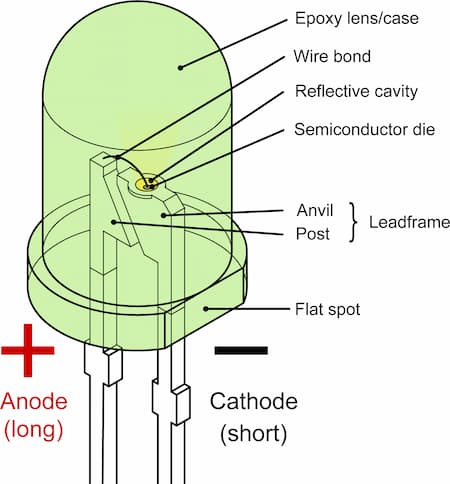
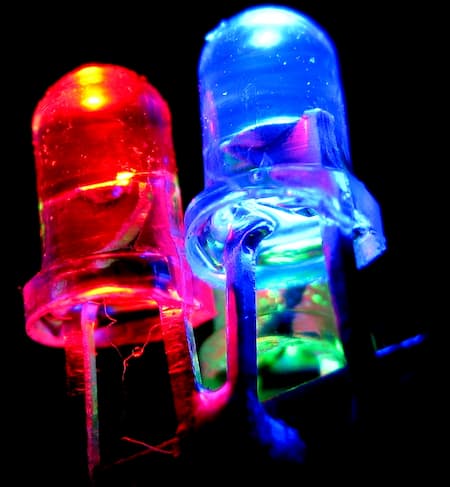
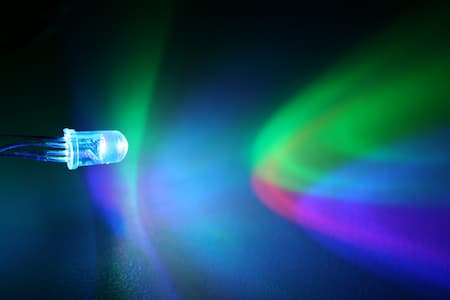
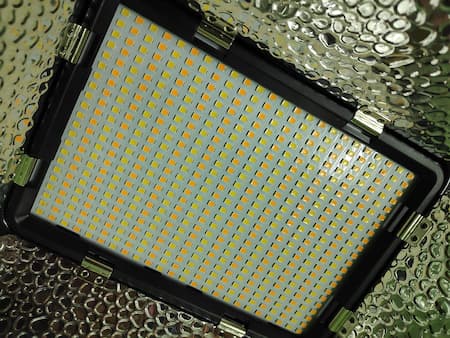
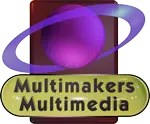 © Multimakers Multimedia
© Multimakers Multimedia